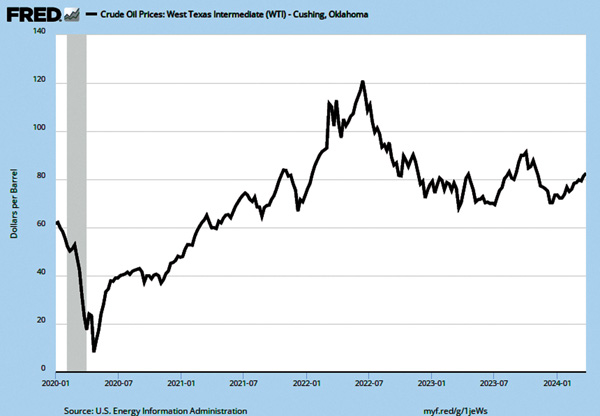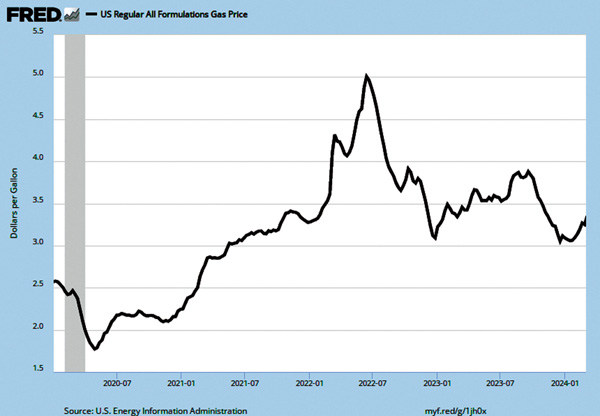
The Myth Busting Economist by Larry Malone
Who Sets the Price of a Gallon of Gas?
My last column set out and busted the myths surrounding the origins of the post-COVID inflation. We discovered that the seeds of inflation were sown on both the supply (shortages of items needed by producers) and demand (high consumer spending to make up for lost time) sides of the economy. And those stimulus checks boosted the savings of many households, which meant more shortages and higher prices when we masked up and resumed spending in a frenzy.
In this column, we bust one of the biggest myths of all—the view of some that POTUS, the president of the United States, sets and/or is solely responsible for changes in the price of gasoline. Think of those little decals that mischief makers placed on gas pumps with the current president pointing and saying, “I Did That!”
The easiest way to debunk this myth is to ask a simple question: Why would any sitting president want to increase the price of gasoline? After all, a meaningful percentage of the voting population casts their ballots according to what has happened to the price of a gallon. For some strange reason, the price of gas has become the barometer of economic well-being. If the price is rising in the run up to an election, some voters will vote AGAINST the incumbent president, no matter what their political party. So those little “I Did That!” stickers, although perhaps good for a chuckle, defy common sense.
What, then, are the real causes of changes in the price of gasoline?
The first thing to understand is that the price of a gallon of gasoline is largely based on the price of a barrel of oil. A barrel of oil consists of 42 gallons, and empty metal oil barrels are sometimes deployed in these parts to float a dock or to burn garbage on the back forty.
The oil market is global, which means the price of a barrel is the same, whether it comes from Alaska, the Middle East, South America, Russia, the North Sea, or the Gulf of Mexico.
Our first Federal Reserve chart (above) shows how volatile the price of a barrel of oil has been since the onset of COVID. The left side of the chart shows the price in dollars per barrel; the bottom indicates dates from January 2020 to the present.
On January 7, 2020 oil was selling for $62.70 a barrel. After COVID shut the economy down in March, oil plummeted to $18.31 on Friday, April 17. When the market reopened on Monday, April 20 the price plunged $55.29, the biggest one-day drop ever. Stranger still, the price of a barrel of oil that day was NEGATIVE, at -$36.98! Owners of a barrel of oil actually PAID purchasers $36.98 to take a barrel off their hands that day. People weren’t driving, so there was plenty of gasoline but little demand for it. Drastic changes in the demand and supply of oil during the COVID shutdown are why a gallon of gas fell from $2.86 in May 2019 to $1.87 a year later—not because the president (Trump at that point) made it happen.

The second chart shows changes in the price of a gallon of gasoline over the same time, from January 2020 to the present. Since gasoline is refined from crude oil, it’s not surprising that changes in oil and gasoline prices (the trend lines on the charts) are mirror images.
Gasoline prices also include taxes. The federal tax per gallon has been 18.4 cents since 1993, but state taxes vary, with California the highest at 77.9 cents per gallon. New York’s gasoline tax is 36.7 cents per gallon, with 12 other states having higher tax rates per gallon.
After declining recently from September through January, gasoline prices have been rising. Is it because Biden doesn’t want to be re-elected, so he’s at it once again, raising our gasoline prices? Noooooo. The REAL reasons are the things currently affecting oil prices, including: the war in Ukraine; weather (which affects distribution costs); oil production cuts by OPEC (12 nations that control 27 percent of the market), and Houthi attacks on ships in the Red Sea (in response to Israel’s actions in Gaza).
Changes in the demand for gasoline also have a large role in explaining recent gasoline price increases. Americans are enamored with super-sized trucks and SUVs, which are less fuel efficient and account for more than half of all passenger vehicles in the U.S. So next time you see a big F350 without a pilot and idling in a parking spot, be sure to recall the now busted myth that the president sets and/or is responsible for changes in the price of a gallon of gas.
Larry Malone is professor emeritus of economics at Hartwick College.

